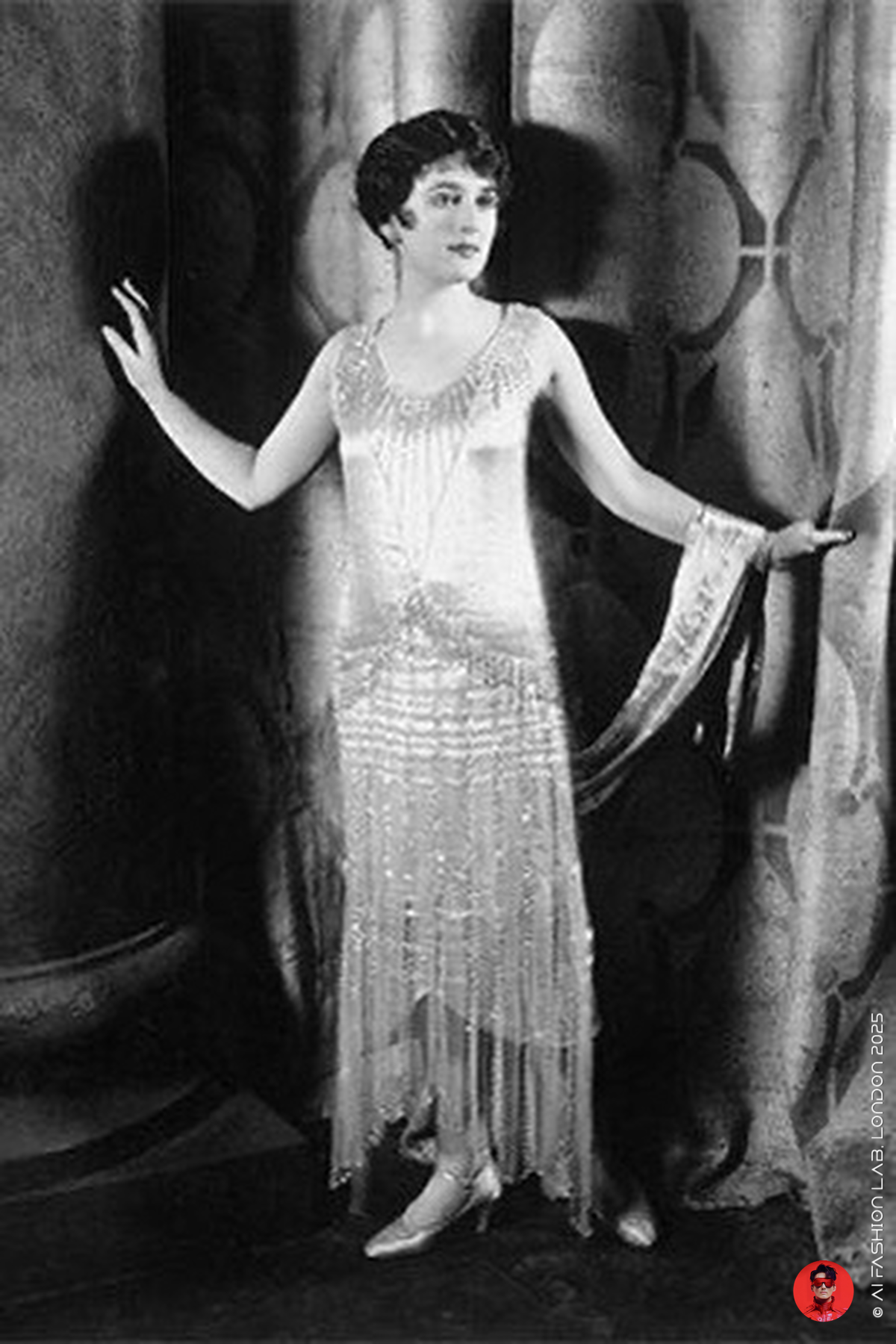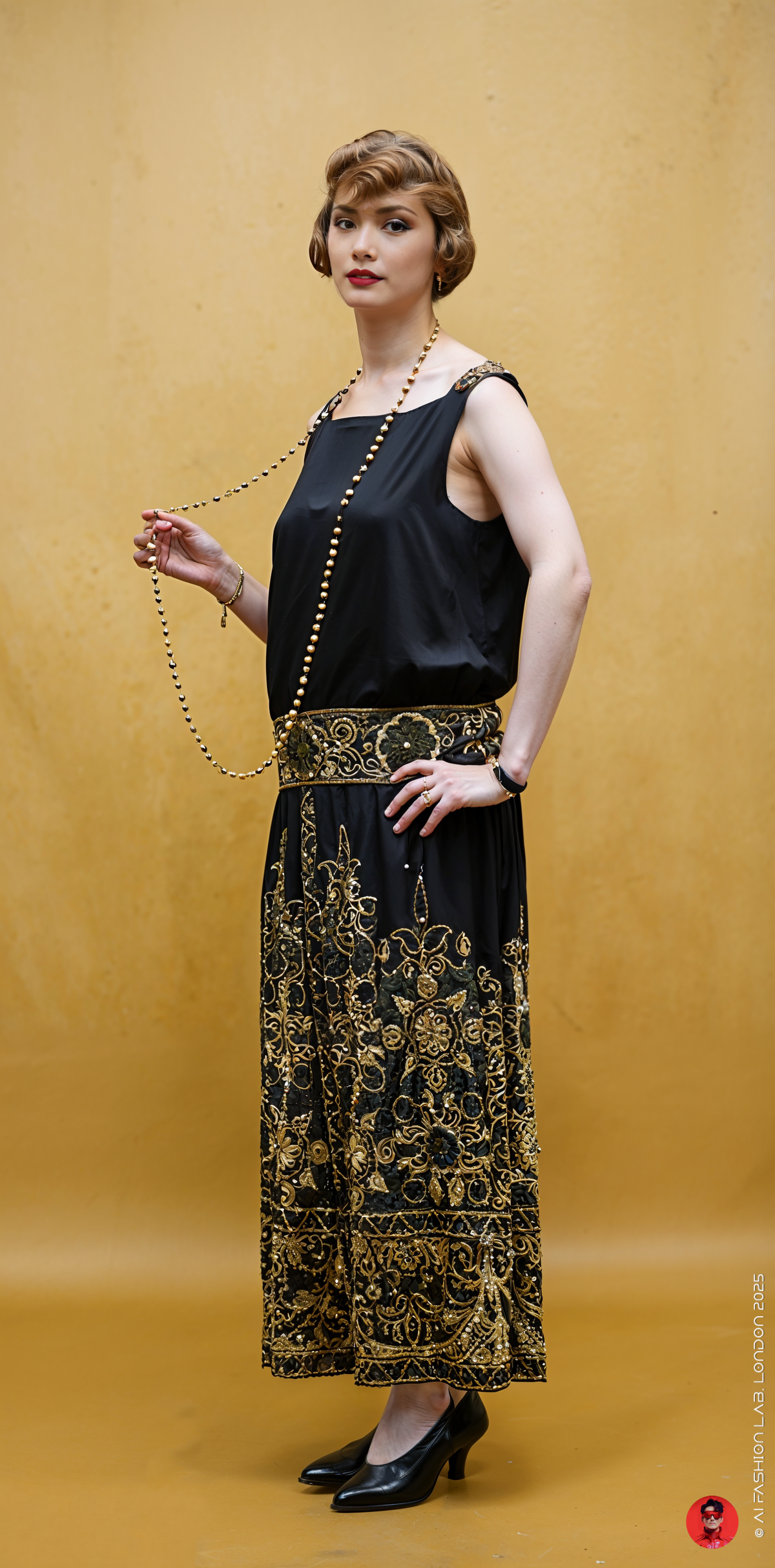วิธีฝึกโมเดล AI ให้เข้าใจแฟชั่นยุค 1920s ในบริบทไทย
วิธีฝึกโมเดล AI Flux LoRA ให้เข้าใจแฟชั่นยุค 1920s ในบริบทไทย
หลังจากที่ผมโพสต์ภาพ คอลเลกชันชุดราตรียุคอาร์ตเดโค ซึ่งได้แรงบันดาลใจจากช่วงต้นรัชสมัยพระบาทสมเด็จพระปกเกล้าเจ้าอยู่หัว หลายคนได้ส่งข้อความมาถามว่า เราจะสร้างภาพรูปทรงหรือโครงร่างแฟชั่น (fashion silhouette) ที่สวยงามและถูกต้องตามยุคสมัยนั้นได้อย่างไร โดยใช้ AI
วันนี้ผมขอแบ่งปันภาพบางส่วนจากดาตาเซ็ตที่ผมใช้ในการทำงาน พร้อมอธิบายกระบวนการเบื้องหลัง ซึ่งประกอบด้วยหลายขั้นตอน และต้องอาศัยความอดทนรวมถึงความใส่ใจในรายละเอียดพอสมควร โดยเฉพาะหากคุณต้องการสร้างผลงานที่มีกลิ่นอายเฉพาะตัวและแฝงด้วยความคิดสร้างสรรค์ แทนที่จะพึ่งพาแอปพลิเคชันระบบปิดที่มักเน้นภาพแฟชั่นแบบตะวันตก
แม้ว่าตอนนี้จะมีแอป AI บางตัว เช่น Google Imagen หรือแพลตฟอร์มในไทยอย่าง Vovariya ที่เริ่มสร้างผลงานศิลปะแบบไทยได้แล้วบ้าง แต่ยังขาดความ “ถูกต้องตามบริบท” เมื่อพูดถึงแฟชั่นไทยในเชิงประวัติศาสตร์ โดยเฉพาะแฟชั่นในช่วงยุคสมัยที่เฉพาะเจาะจง ดังนั้นผมจึงเลือกฝึก โมเดล LoRA (Low-Rank Adaptation) ขึ้นมาเอง เพื่อความแม่นยำทางประวัติศาสตร์และควบคุมสไตล์งานได้ตามต้องการ
๑. เริ่มต้นด้วยแนวคิดและการวางแผน
สำหรับคอลเลกชันนี้ ผมตั้งใจจะนำเสนอ ชุดราตรีแบบตะวันตก ในช่วงปี 1920s ที่ได้รับความนิยมในกลุ่มหญิงไทยชนชั้นสูงในสมัยนั้น เนื่องจากภาพถ่ายของคนไทยในงานเลี้ยงหรือโอกาสไม่เป็นทางการในยุคดังกล่าวมีค่อนข้างน้อย ส่วนใหญ่เป็นภาพถ่ายในราชสำนักหรือในโอกาสสำคัญทางพิธีการ
ในยุคนั้น การถ่ายภาพยังไม่สะดวกเหมือนทุกวันนี้ การใช้แฟลชต้องใช้หลอดไฟแฟลชขนาดใหญ่และไม่เหมาะกับงานสังสรรค์ทั่วไป อีกทั้งวัฒนธรรมการถ่ายภาพในงานปาร์ตี้ก็ยังไม่แพร่หลายเหมือนในยุคโซเชียลมีเดีย
ผมจึงเลือกอ้างอิงจาก แหล่งข้อมูลแฟชั่นตะวันตกในยุค 1920s เช่น นิตยสารเก่า หนังสือแฟชั่น หรือ Pinterest แล้วคัดเลือกภาพที่มีหลากหลายท่าทางและมีรูปทรงของชุด (silhouette) ที่สอดคล้องกัน จำนวนประมาณ 50–100 ภาพ
๒. การลงสีภาพและปรับใบหน้า
เมื่อรวบรวมภาพได้แล้ว ผมได้นำมาลงสีทั้งหมดด้วยเครื่องมือ AI อย่าง Flux Kontext เพื่อให้ภาพดูมีมิติที่ชัดเจนยิ่งขึ้น ทั้งในเรื่องของเนื้อผ้า เงา และแสงตกกระทบ ซึ่งล้วนมีความสำคัญในการฝึกโมเดล AI ให้เข้าใจแฟชั่นในเชิงโครงสร้าง และรูปทรงของแฟชั่นที่ชัดเจน อีกทั้งยังช่วยให้โมเดล "รับรู้" ว่าภาพเหล่านี้เป็น ภาพสี ไม่ใช่ภาพขาวดำ
ในขั้นตอนนี้ ไม่จำเป็นต้องกังวลว่าการลงสีจะต้องสอดคล้องกับสเกลสีแบบ grayscale เสมอไปนะครับ—เราสามารถลงสีได้ตามจินตนาการ เพราะเป้าหมายหลักคือการสอนให้ AI เข้าใจว่า “นี่คือภาพแฟชั่นสี”
ในงานลงสีภาพถ่ายแบบดั้งเดิม เทคนิคที่เรียกว่า “Greyscale Technique” คือการตีความระดับเฉดสีเทาในภาพขาวดำให้กลายเป็นสีที่สมจริง โดยคำนึงถึงสมดุลของแสง เงา และความสว่างตามธรรมชาติ
อย่างไรก็ตาม ในบริบทของการฝึกโมเดล AI โดยเฉพาะเมื่อใช้กับภาพแฟชั่นในเชิงประวัติศาสตร์ เป้าหมายของเราไม่ใช่การจำลองสีให้ตรงเป๊ะกับของจริง แต่คือ การให้ AI เรียนรู้ว่าภาพเหล่านี้เป็นภาพสี ดังนั้นเราจึงสามารถลงสีอย่างมีอิสระ เพื่อเน้นรายละเอียดของโครงร่างชุด เนื้อผ้า และลักษณะเฉพาะของแฟชั่นได้อย่างเต็มที่ แล้วค่อยกำหนดเฉดสีที่แม่นยำในภายหลังผ่านคำสั่ง prompt หรือการปรับแต่งภาพเพิ่มเติม
จากนั้น เมื่อได้โมเดล LoRA ที่ผ่านการฝึกแล้ว เราสามารถใช้ prompt เพื่อระบุเฉดสีของแต่ละส่วนในเครื่องแต่งกายได้อย่างตรงจุด
เพื่อคงไว้ซึ่ง อัตลักษณ์ของความเป็นไทย ผมจึงเลือกใช้เทคนิค face swap เปลี่ยนใบหน้าของนางแบบทั้งหมดให้เป็นหญิงไทยหรือหญิงเอเชีย แม้ว่าชุดที่สวมจะเป็นแฟชั่นตะวันตกในยุคนั้นก็ตาม ภาพที่ได้จึงยังคงสะท้อนความงามแบบไทย และช่วยให้โมเดลสามารถเชื่อมโยง “บุคลิกไทย” เข้ากับบริบทของแฟชั่นยุค 1920s ได้อย่างเป็นธรรมชาติ
๓. กำหนดจุดเน้นของโมเดล LoRA
สำหรับ LoRA ตัวนี้ ผมต้องการให้โมเดลเรียนรู้:
รูปทรงชุดราตรียุค 1920s
ทรงผม Marcel Wave ที่ได้รับความนิยมในยุคนั้น
ฉากหลังที่เป็น งานตกแต่งภายในแบบ Art Deco
ผมจึงเตรียมชุดภาพเพิ่มเติมสำหรับทรงผม (จากโมเดล LoRA ตัวก่อนที่เคยฝึกไว้) และภาพตกแต่งภายในที่มีดีไซน์ Art Deco อย่างแท้จริง โดยกำหนดสัดส่วนของภาพในชุดฝึกไว้ที่:
๗๐% เป็นภาพชุดราตรี
๒๐% เป็นภาพทรงผม
๑๐% เป็นภาพฉากหลังหรือสถาปัตยกรรม
การจัดสัดส่วนเช่นนี้ทำให้โมเดลโฟกัสไปที่แฟชั่นเป็นหลัก โดยยังมีบริบทด้านทรงผมและฉากหลังประกอบอย่างกลมกลืน
๔. การใส่ภาพฉากหลังในการฝึก
แม้ว่าเราจะสามารถกำหนดฉากหลังได้ผ่าน prompt แต่จากประสบการณ์ของผม การใส่ภาพฉากหลังเข้าไปโดยตรงในชุดฝึก LoRA จะทำให้โมเดลจดจำดีไซน์และองค์ประกอบของฉากได้แม่นยำยิ่งกว่า เช่น ผนังไม้ในแบบ Art Deco, ลวดลายทองเหลือง, และพื้นหินอ่อน ล้วนถูกบรรจุไว้ใน dataset เพื่อให้ AI สร้างภาพใหม่ที่มีองค์ประกอบเหล่านี้โดยอัตโนมัติ
ผมหวังว่ากระบวนการนี้จะเป็นจุดเริ่มต้นที่เป็นประโยชน์สำหรับผู้ที่อยากฝึกโมเดล AI อย่างมีบริบทและความเข้าใจในวัฒนธรรม แม้จะต้องใช้เวลา แต่ในยุคที่มี ภาพ AI ถูกสร้างขึ้นนับล้านต่อวัน เราจะทำให้งานของเรามีเอกลักษณ์ได้อย่างไร?
คำตอบคือ ต้องมี บริบททางวัฒนธรรม ความคิดสร้างสรรค์ และจุดยืนของตัวเราเอง ครับ
ในฐานะนักออกแบบเครื่องแต่งกาย ผมเชื่อว่า AI ไม่ใช่แค่เครื่องมือสร้างภาพสวย ๆ เท่านั้น แต่ยังเป็น “พาหนะ” ที่สามารถช่วย อนุรักษ์ประวัติศาสตร์แฟชั่นไทย ถ่ายทอดความรู้ สร้างบทสนทนา และส่งต่อองค์ความรู้ในระดับชาติได้อย่างทรงพลัง—หากเราใช้มันอย่างมีจริยธรรมและตระหนักรู้
How to Train an AI Model Flux Lora to Understand 1920s Fashion in the Thai Context
In my previous post featuring the Art Deco Evening Dress Collection from the early reign of King Rama VII, many readers messaged me asking how to create historically accurate fashion silhouettes from that era using AI. Today, I’d like to share a selection of images from the dataset I use in my creative process, along with an explanation of the workflow behind them. It involves several steps and requires a fair amount of patience and attention to detail—especially if you want your work to carry a distinctive character and creative vision, rather than relying on closed-system applications that often prioritise Western-style fashion aesthetics.
While some AI apps, like Google Imagen or Thai-specific platforms such as Vovariya, are improving in generating Thai-inspired visuals, they still fall short when it comes to the authenticity and nuance of historical Thai fashion. That’s why I train my own LoRA (Low-Rank Adaptation) models—to ensure historical accuracy and artistic control.
1. Start with Concept and Planning
For this collection, I wanted to focus on evening dresses in Western styles, inspired by Thai aristocracy and court women during the 1920s. Authentic photographs from this period are rare—especially of social events—since most were formal studio portraits or taken during royal functions. Flash photography was still cumbersome, and unlike today’s celebrity culture, private parties weren’t widely photographed.
To fill these gaps, I turned to 1920s Western fashion sources—vintage magazines, archives, and curated Pinterest boards. I looked for a consistent silhouette across 50–100 photos, capturing various poses and styles within the eveningwear theme.
2. Colourisation and Face Adjustment
Once I had gathered the reference images, I colourised them using the AI tool Flux Kontext. This process enhanced the visibility of fabric textures, shadows, and depth—elements that are essential when training an AI model to understand fashion in terms of structure and material quality. It also helped the model recognise the images as colour photographs, rather than black-and-white archival ones.
At this stage, there's no need to worry about matching the colours precisely to historical greyscale references—you are free to colourise creatively. The primary goal is to teach the AI that these are colour images. In traditional photo colourisation, the greyscale technique refers to carefully translating tonal values—shades of grey in black-and-white photos—into realistic colours, while maintaining correct light logic and contrast. But in the context of AI model training for fashion, especially with historical datasets, accuracy in colour is secondary to teaching the model the visual logic of colour itself.
This flexibility allows us to colourise with more creative freedom, focusing on highlighting fabric quality, silhouette, and detail rather than perfectly replicating historical palettes. Later, once the LoRA model is trained, colour accuracy can be refined by using prompts or image adjustments during generation.
To preserve a strong sense of Thai identity, I used face swap techniques to replace all model faces with Thai or East Asian women. While the clothing styles remain Western, this approach grounds the visual narrative within a Thai context, allowing the AI to associate 1920s fashion with Asian facial features and cultural nuance more intuitively.
3. Define the Focus of Your LoRA
For this model, I wanted the LoRA to recognise:
1920s evening dress silhouettes
Marcel wave hairstyles
Art Deco interiors
Therefore, I curated additional images for hairstyles (from a previous LoRA I trained) and interiors (using authentic Art Deco designs). The ideal ratio in the dataset was:
70% dress styles
20% hairstyles
10% interior/backdrop
This weighting helps the model prioritise the fashion silhouette while still integrating appropriate hairstyling and architectural context.
4. Include Interior Backdrops Intentionally
Although you can specify backgrounds in your prompt, I find that including interior design styles directly in the training set helps the model internalise them. Art Deco wood panels, metallic décor, and marble flooring were part of the training so that the model naturally generated these elements without needing overly detailed prompts later.
I hope this method offers a practical starting point for those who want to train AI models with cultural and historical sensitivity. Yes, it takes time. But in an era when millions of AI-generated images are created daily, how do we make our work stand out? By ensuring it reflects our culture, context, and creativity.
As a costume designer, I believe AI can be more than just a tool—it can be a vehicle for preserving fashion history, building national knowledge, and creating meaningful cultural content. Let’s use it wisely.
#aifashionlab #AI #aiartist #aiart #aifashion #aifashiondesign #aifashionstyling #aifashiondesigner #fashion #fashionhistory #historyoffashion #fashionstyling #fashionphotography #digitalfashion #digitalfashiondesign #digitalcostumedesign #digitaldesign #digitalaiart #ThaiFashionHistory #ThaiFashionAI #thailand #UNESCO

































































